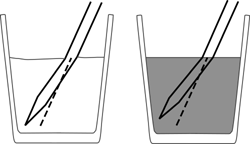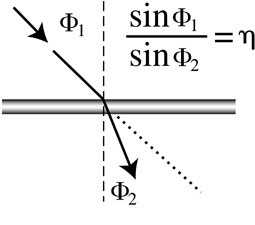
Finishing Publications Ltd &
Metal Finishing Information Services
Metal Finishing : Surface Engineering : History of Technology : CD-ROM : Books : Helpline : Information to help you and your business
ANALYSIS OF METAL FINISHING BATHS
A key to Quality, Productivity, Cost-Savings and a Cleaner Environment
Browse the
resources listed on the left to see how important Analysis is in maintaining
high quality and maximising profitability in Metal Finishing operations.
2.3
Refractive Index * or **
Take a look at a spoon, or a stick, immersed in water in a transparent jar, and it will appear to be bent. This is caused by a phenomenon known as the refraction of light. Place two identical sticks in two identical vessels, filled to the same level but with different liquids, as shown below, and it can be seen that the extent of the "bending" is different in each case. This is because the two liquids have different refractive indices or "bending power".

The scientific explanation is that the velocity of light differs, depending on the medium (air, water, paraffin) through which it is passing. We can express this formally, using the diagram shown below.

This shows light passing from a less dense medium, such as air, (top) into a denser one (below) such as sulphuric acid. The light beam is seen to bend towards the normal. The angles to the normal are known as the "angle of incidence" and the "angle of refraction", and the simple equation relates these two angles to the refractive index, usually designated "h ", or "R.I".
This is the basis of a very simple and extremely useful technique sometimes known as "refractometry", though unfortunately, the term has also been appropriated by optometrists, who use it to describe the practice of prescribing spectacles!
Refractometers, the instruments used to measure refractive index, range from very convenient handheld instruments, small enough to be held in the pocket, through larger (and more accurate) benchtop models. In the food and beverage industries, the technique is also used for continuous on-line measurement.
Because refractive index is a bulk property of solution, a given RI value can never be completely unique. In the case of simple mixtures of A+B (for example water + alcohol), an RI value will be unique to that particular combination of solvents and in such cases, this is a highly recommended analytical technique. In the beverage industries, it is used, for example, to determine the concentration of dissolved sugar, in water. In Metal Finishing, it is used to determine chromic acid concentrations, or cleaner compositions. In the printed circuit board industry, it is used for on-line analysis of etch baths.
But what if there are two species dissolved in a solvent, for example sugar and alcohol, or copper sulphate and ferrous chloride ? The answer, in line with what was stated above, is that the two concentrations cannot be determined – at least not with a single measurement. There are, however, various simple methods of overcoming this problem.
Like all apparently simple techniques, certain precautions must be taken. In certain cases, the technique can be used even when suspended matter is present in solution.
The Special Report "Analysis of Metal Finishing Solutions Using Refractive Index Measurements" describes the techniques, and their application in the Metal Finishing industry. US$ 15.00, delivered by email free of charge. By post add $3.00